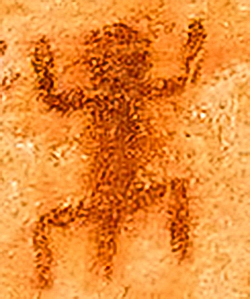Finding ancient pictograms (or rock art) is one of the many joys of hiking in the American Southwest. These paintings or figures and shapes carved into rock were made by the ancestors of today’s indigenous peoples: Hopi, Havasupai, or others. Even for those of us whose ancestors immigrated to the United States since 1492 (or who were brought as slaves), these images help us connect to the people and the land where we now live. As Americans, we are surely their spiritual, if not biological, descendents.
I took the picture above while hiking in the Grand Canyon in 2010. I can’t be more specific about its location — pictograms are frequently targeted by “collectors” (read: plunderers). Wanting to learn more about the people who made these pictograms, I searched several online databases without any luck. Eventually, I contacted Ellen Brennan, Cultural Resources Program Manager at Grand Canyon National Park. From the photo above, she was able to identify both the people who likely created the rock art, and provide an estimate of when it was made.
Here’s Ms. Brennan’s reply to my questions:
The rock art you photographed has been attributed to the Cohonina people who were one of the early cultural groups in the Grand Canyon (and other localities in the Flagstaff region). The archaeologists who recorded this site estimated its age between A.D. 900 and A.D. 1150, though much of our research suggests that Cohonina archaeological materials are not found in the Canyon after A.D. 1050. This suggests that they either left the area or intermarried into larger groups of people (possibly the Kayenta Ancestral Puebloan people) and took on the traits of their adopted society.
Just who the Cohonina were as a cultural group is still somewhat of an unanswered question. As you may know, archaeologists classify prehistoric cultures by examining a series of traits, such as how people built their homes, how they made pottery, the ways in which they “made their living” (hunting and gathering, agriculture, some combination of those two traits), how they buried their dead.
We believe the Cohonina made a particular kind of pottery, San Francisco Mountain Gray Ware, but they show variations in the ways they built their homes and the way they made their living. Much more research is needed to understand who these people were in a scientific sense. Some archaeologists believe they are ancestors of modern pueblo people (Hopi), while others do not. You can find a little information on the web, but be careful of some of the sites. There is one that states the Cohonina have been around for 8,000 years. The archaeological evidence does not support that. I refer you to the works of Dr. Alan Sullivan of the University of Cincinnati for his research into this culture.
If you find ancient rock art, please don’t touch it (the oil from our skin can dissolve the paint). Just be grateful for your good luck and enjoy its beauty.
The image from the Grand Canyon can be purchased at the Art for Conservation online gallery. (Ten percent of profits goes to support the work of the Grand Canyon Trust.)




